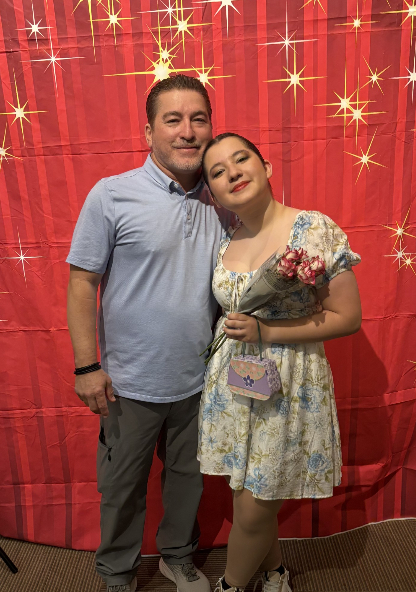Emily Lives Strong with Type 1 Diabetes
When Emily Babilonia Fernandez was seven years old, she was an energetic little girl—always smiling and full of life. Then, just six months after her family moved to San Antonio from Florida, everything changed.
Empowering Families: Emily's Endocrinologist at CHRISTUS Children's
I knew something was very wrong,” recalled Emily’s mom, Mariemil Fernandez. “She was sick all the time—sore throats, ear infections. The pediatrician prescribed medicine, but nothing helped.
It was December 27, 2017, and the family had just celebrated Christmas. But Emily hardly participated. In her own words, she was “absolutely exhausted and just wanted to sleep.”
I was so thirsty and hungry all the time,” Emily said. “I couldn’t stop going to the bathroom, but at the same time, I was losing weight!
Emily’s dad, Javier, a truck driver, had just gone back out on the road when he received a terrifying phone call: Emily had collapsed and was being rushed to the Emergency Department at CHRISTUS Children’s in San Antonio—over two hours away.
As soon as we arrived at CHRISTUS Children’s, we knew something was wrong,” Mariemil said. “They did bloodwork and diagnosed Emily with type 1 diabetes.
The diagnosis hit close to home. Javier had been diagnosed with type 1 diabetes in his late teens, so the family already understood the challenges ahead. Mariemil believes her years of cooking diabetic-friendly meals may have helped delay Emily’s symptoms. After all, she had made it to age seven before showing signs of the disease.
But now, Emily’s type 1 diabetes had come on with a vengeance.
Understanding Diabetes
There are two main types of diabetes. Type 1 diabetes occurs when the body doesn’t produce enough insulin, an essential hormone that helps glucose (sugar) enter the body’s cells for energy. Type 2 diabetes develops when the body either doesn’t produce enough insulin or can’t use it effectively.
Diabetes can be diagnosed at any age, and while there is no cure, it can be managed successfully with proper care. Many people with diabetes lead full, healthy lives. However, if left uncontrolled, the condition can lead to serious and potentially life-threatening complications.
What Is Diabetic Ketoacidosis?
When Emily was admitted to CHRISTUS Children’s, she was in diabetic ketoacidosis (DKA)—a serious complication that occurs when blood sugar levels remain extremely high for too long. In response, the body begins breaking down fat for energy, producing acids called ketones. When too many ketones build up in the bloodstream, they can become dangerous.
Emily spent two days in the Intensive Care Unit and five more days under observation at CHRISTUS Children’s while her blood sugar stabilized. By New Year’s Day, her condition was under control.
The doctors were excellent. The nurses acted fast and explained everything,” Mariemil said.
Learning to Manage Diabetes with CHRISTUS Children’s
I always knew there was a chance she could be diagnosed with diabetes one day,” Javier said.
Once she was, I told her that managing it would become part of her life now. She would have to keep an eye on her blood sugar and her A1C.
A1C is a blood test that shows a person’s average blood sugar levels over the past two to three months. It helps doctors determine how well diabetes is being controlled.
Those early days of managing her diabetes were a nightmare, Emily admitted. She hated needles, and during her hospital stay, it felt like every time she turned around, someone was there to check her blood sugar. After she was discharged, her mom took over the testing and insulin shots. But Emily still needed a long-acting insulin injection every morning, and her blood sugar had to be checked several times a day. Whenever the numbers were off, Mariemil would give her another insulin shot.
A couple of years later, Emily received a Continuous Glucose Monitor (CGM)and an insulin pump. She wears both every day, and they work together to continually track her glucose levels. When needed, the pump automatically delivers the right dose of insulin to stabilize her levels. Emily manages her care with the help of an app on her phone.
It’s so much better not having to get the shots anymore,”
Emily said. “We change the pump every few days and the monitor every week. Sometimes it hurts to change them, but it’s worth it because I feel better and don’t have to think about my diabetes all the time.”
Monica Dussan, MD, division chief of Pediatric Endocrinology at CHRISTUS Children’s, is Emily’s endocrinologist and has helped her manage the condition for several years.
Emily is the perfect example of how, with the right education, tools and support, children with type 1 diabetes can live full and active lives,” said Dr. Dussan. “Our goal is to empower families to understand the condition and manage it confidently so kids like Emily can keep doing the things they love.
I really like Dr. Dussan,” Emily said. “She’s kind and always explains things so I understand what’s happening and what to do when my sugar goes up or down.
Mariemil agreed.
The doctors and nurses at CHRISTUS Children’s are excellent. I wouldn’t want to take her anywhere else for care.
Life Beyond Diabetes
Emily hasn’t let diabetes slow her down. Now 15, she’s a high school sophomore in San Antonio and stays active in ballet, jazz, contemporary and modern dance.
The doctors at CHRISTUS Children’s are caring and supportive,” said Mariemil. “They’ve gotten to know us, and they’re so patient.
Javier added, When they found out Emily had diabetes, she was in bad shape. The doctors before didn’t diagnose it, so getting to the right hospital made all the difference. You have to understand that diabetes can show up in many ways and at any time. If you’re at risk, it’s important to get checked early and learn how to manage it. The sooner you know, the better you can live with it.
A Message for Diabetes Awareness Month
November is Diabetes Awareness Month. Emily’s story reminds us that getting tested and learning about the disease after diagnosis is the key to managing it and maintaining a quality of life that you love.
Prevent things from going further than they have to,” Mariemil said. “Get checked, learn about it and take it seriously.
Emily agreed.
For more information about Pediatric Endocrinology at CHRISTUS Children’s in San Antonio, Texas, please visit: Pediatric Endocrinology in San Antonio | CHRISTUS Children's Hospital



